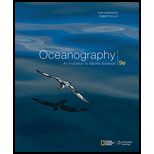
The reason why water tend to flow around the periphery of ocean basin, the reason why western boundary currents are the fastest ocean currents, and the way in which they differ from eastern boundary currents.
Answer to Problem 1TC
The flow of water flow in a gyre may be actively balanced between the downhill affinity of the pressure gradient and the uphill trend of Coriolis deflection. The balance of the Coriolis Effect and the pressure gradient, and of wind energy and friction drive the currents of the gyre, causing them to flow along the outer margins of the ocean basin.
The western boundary currents are likely to be fast, hot, and deep, whereas the eastern boundary currents are likely to be slow, cold, and shallow. The volume of water carried by western boundary currents are greater than the ones carried through eastern boundary currents.
Explanation of Solution
Reason due to which water tend to flow around the periphery of ocean basin
Piling up of the moving water occurs in the direction the wind is gusting. The piled-up side experiences higher water pressure, followed by the pulling of water downslope due to gravity against the pressure gradient, in the direction of its origin. However, any mass moving on the Earth will be affected by the Coriolis force. Hence, due to the interference of Coriolis Effect, the flow of surface current gets deflected to the right in the Northern Hemisphere and to the left in the Southern Hemisphere.
The condition of the North Atlantic surface water is taken for instance. It is elevated through Ekman transport and wind motion to develop a low hill. The water moving toward west may be balanced between the Coriolis Effect, which might cause the deflection of water to the right, and pressure gradient brought about by gravity might turn the water to the left. Therefore, as a result of the balance between all these forces, water in a surface current flows along the outside margin of an ocean basin.
Differences between western boundary currents and eastern boundary currents
When the top of the hill created in a rotating gyre remains closer to the western boundary compared to the gyre’s geographic center, then it can be designated as a western intensified current. It is noted that the western boundary currents of the subtropical gyres are western intensified (even in the Southern Hemisphere), which means that they flow along the western margins of the ocean basin in both Northern and Southern Hemispheres. These western margins, which are off the continents’ east coast, are the locations of the deepest and fastest geostrophic currents. It can be said that the western intensification of the western boundary currents are due to the rotation of the Earth and the resultant Coriolis force.
The western boundary currents, which include the Japan or Kuroshio Current (found in the North Pacific), the East Australian Current (found in the South Pacific), the Gulf Stream (found in the North Atlantic), the Brazil Current (found in the South Atlantic), and the Agulhas Current (found in the Indian Ocean), are characteristically swifter, deeper, and narrower than their counterparts in the eastern boundary. They carry a large volume of warm water from the lower latitudes to poleward, exhibiting no or little upwelling.
The eastern boundary currents are also five in numbers like the western boundary currents, and they are the California Current (found in the North Pacific), the Peru or Humboldt Current (in the South Pacific), the Canary Current (found in the North Atlantic), the Benguela Current (found in the South Atlantic), and the West Australian Current (found in the Indian Ocean). Unlike the western boundary currents, the eastern boundary currents flow along the eastern edge of ocean basins, which is off the continents’ west coast.
The eastern boundary currents transport cold water toward the equator and are usually almost
Want to see more full solutions like this?
Chapter 9 Solutions
Oceanography: An Invitation To Marine Science, Loose-leaf Versin
 Applications and Investigations in Earth Science ...Earth ScienceISBN:9780134746241Author:Edward J. Tarbuck, Frederick K. Lutgens, Dennis G. TasaPublisher:PEARSON
Applications and Investigations in Earth Science ...Earth ScienceISBN:9780134746241Author:Edward J. Tarbuck, Frederick K. Lutgens, Dennis G. TasaPublisher:PEARSON Exercises for Weather & Climate (9th Edition)Earth ScienceISBN:9780134041360Author:Greg CarbonePublisher:PEARSON
Exercises for Weather & Climate (9th Edition)Earth ScienceISBN:9780134041360Author:Greg CarbonePublisher:PEARSON Environmental ScienceEarth ScienceISBN:9781260153125Author:William P Cunningham Prof., Mary Ann Cunningham ProfessorPublisher:McGraw-Hill Education
Environmental ScienceEarth ScienceISBN:9781260153125Author:William P Cunningham Prof., Mary Ann Cunningham ProfessorPublisher:McGraw-Hill Education Earth Science (15th Edition)Earth ScienceISBN:9780134543536Author:Edward J. Tarbuck, Frederick K. Lutgens, Dennis G. TasaPublisher:PEARSON
Earth Science (15th Edition)Earth ScienceISBN:9780134543536Author:Edward J. Tarbuck, Frederick K. Lutgens, Dennis G. TasaPublisher:PEARSON Environmental Science (MindTap Course List)Earth ScienceISBN:9781337569613Author:G. Tyler Miller, Scott SpoolmanPublisher:Cengage Learning
Environmental Science (MindTap Course List)Earth ScienceISBN:9781337569613Author:G. Tyler Miller, Scott SpoolmanPublisher:Cengage Learning Physical GeologyEarth ScienceISBN:9781259916823Author:Plummer, Charles C., CARLSON, Diane H., Hammersley, LisaPublisher:Mcgraw-hill Education,
Physical GeologyEarth ScienceISBN:9781259916823Author:Plummer, Charles C., CARLSON, Diane H., Hammersley, LisaPublisher:Mcgraw-hill Education,





